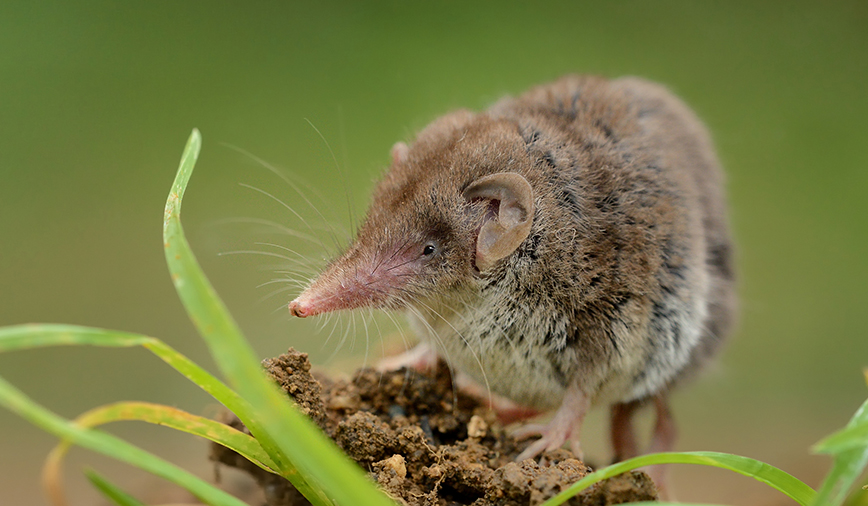We had a visitor stop by last week, unannounced but not unwelcome. He, or maybe she, was clearly on a mission, driven by instinct, hunger and a will to survive.
She, or maybe he, was tiny—only a few centimeters in length—but mighty, and we marveled as it plowed purposefully forward through the woodchips beneath the Pottawatomie birdfeeders. Leaving a small furrow in its wake, s/he looked a lot like an itsy bitsy bulldozer and even a little like a miniature Bugs Bunny, perhaps tunneling along on its way toward making a wrong turn at Albuquerque.
Who was this dinky digger? Its head flashed briefly above ground, and we caught a glimpse of two small, beady eyes peering out from either side of a long, pointy nose. The overall impression was of a shrewd individual. And shrewd would be an apt description, for the visitor was in fact a shrew.
Shrews aren’t the sort of wildlife that typically grab headlines. Though fierce predators, they don’t eat pets like our area’s famous, or infamous, coyotes do. They’re not exotic or endangered. And, let’s face it— gray in color and an ounce or less in weight, shrews are the sort of animal you could literally walk right over and not even notice.
But shrews are noteworthy nonetheless. For one thing, although they resemble mice, they’re most certainly not rodents. They, along with their cousins the moles, are insectivores, animals that specialize in eating chewy, ewwy bugs. Their teeny teeth provide excellent clues to the shrews’ predatory nature—incisors, canines and molars are all sharply pointed, all the better to eat eww with, my dear.
Second, shrews have amazingly high metabolic rates and need to consume several times their own body weight in prey each day just to survive. To folks like me who have, shall we say, “hearty” appetites, the shrew’s lot in life sounds like a dream come true…until you consider the price of such extravagance. That fast metabolism burns calories so quickly, shrews can only sleep for short intervals or they risk starving to death.
Third, one species of shrew we have right here in the TriCities belongs to an elite group that consists of only a few species worldwide: the venomous mammals. The northern short-tailed shrew, very common in our woods and grasslands, produces a toxin in its salivary glands. It is delivered through a groove between the lower incisors and comes in quite handy when the shrew must subdue prey animals as large, or larger, than itself.
Ever hear of The Killer Shrews? In this horror movie from the late 1950s, giant shrews terrorize people with, among other things, venomous saliva. Not to worry, though. In real life, even northern short-tailed shrews are small by human standards. Weighing in at somewhere between 0.5 and 1.0 oz., about as much as a grape, and measuring about 4 in. long, these shrews pose little threat to people. (Leave them alone, they’ll leave you alone.)
But by shrew standards, the Blarina brevicauda is indeed a giant-sized killer. Its relative bulk and venomous bite allow it to take a variety of prey, ranging from insects and earthworms to voles, mice and even other shrews.
Locally, there likely are no less than two other shrew species the short-tailed shrew may dine upon: the masked shrew and the least shrew. Despite their names, the masked shrew is not masked, and the least shrew is not the smallest shrew around—that honor goes to the rare pygmy shrew, which at 0.1 oz weighs about as much as one thin dime.
Shrews through the ages have acquired a somewhat less than desirable reputation (thank you, William Shakespeare) but in truth these little critters perform a valuable service by helping keep insect and rodent populations in check. Even better, they’re abundant throughout much of our area.
Think your lawn or garden doesn’t have a resident population of insectivores? Have we got shrews for you!
Pam Otto is the manager of nature programs and interpretive services for the St. Charles Park District. She can be reached at potto@stcparks.org or 630-513-4346.

